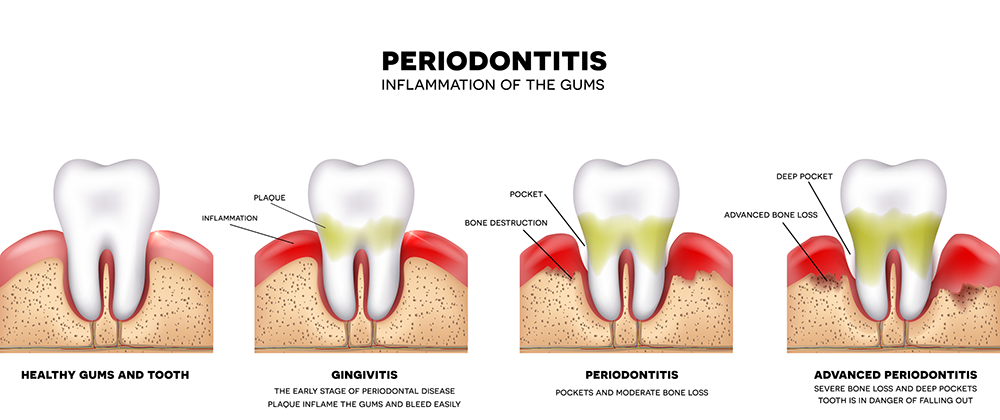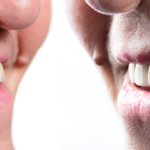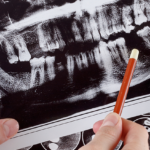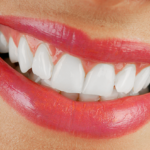What is Periodontal Disease?
Of the hundreds of different types of bacteria in the mouth, anaerobic bacteria cause periodontal disease, most commonly called gum disease, once known as pyorrhea. Mouth bacteria form a biofilm around the teeth and can cause infected gums. When your gums, bones, and ligaments (the supportive structures around your teeth) are compromised, you have periodontal disease, which eventually could cause tooth loss. Besides the other general health issues gum disease can cause, life is usually better with your teeth! Your entire mouth may not always be diseased, as localized periodontal disease can sometimes be limited to a few teeth. There are several reasons for the accumulation of anaerobic bacteria, including genetics, smoking, poor or neglected oral hygiene, and autoimmune disorders. This progressive disease begins as gingivitis with many warning signs, and it is essential to have annual dental hygiene exams to evaluate your gum health. Our Mexico clinics have a periodontist on staff, and periodontitis treatment is much more affordable than treating periodontal disease in the U.S.
A Periodontal Dental Evaluation
Four out of five adults are said to have a stage of gum disease. Periodontal disease can be prevalent, with symptoms not always apparent to the average person. Gum pockets can form quickly in the molar areas, yet these teeth are more hidden and depend on a dental professional to examine them. It is essential to have a current set of full mouth X-rays to determine if there is bone loss. X-rays and an official exam of your teeth and gums are necessary to assess your overall gum health and see if periodontitis treatment is needed. A periodontal probe will be used to measure the spaces in your gums. Six measurements are taken per tooth, where a healthy sulcus (space) measurement is between 1-3 mm, and anything over 4 mm is charted as inflammation or pockets. Many people don’t realize your gums are not fixed to the teeth where the gumline and teeth meet. The sulcus is the open space between the gumline/tooth junction and where the gum attaches to the tooth, 1-3 mm below. The anaerobic bacteria, or plaque, loves to harbor in this space, and your dental hygienist or our dentists in Mexico, will take into account how much plaque is found under the gum, as this is what eventually causes the deepening of the sulcus, which form periodontal pockets.
Symptoms of Gum Disease You may Notice on Your Own, Which May Mean Periodontitis Treatment is a Necessity:
- Persistent bleeding or red gums
- Aching or swollen gums
- Periodontal abscesses on the outside of the gums
- Bad breath or taste in your mouth
- Recession
- Visible tartar
- Loosening teeth
Possible Links to General Health and Periodontal Disease
- Heart disease
- Stroke
- Diabetes
- Dementia
- Rheumatoid arthritis
- Overall body inflammation
- Premature birth or low birth weight
Treating Periodontal Disease
Periodontitis will not get better on its own. Combining new and committed oral home care with the care of dental professionals can reverse most gum diseases, depending on how advanced it is. Sometimes, a combination of periodontitis treatments is required per the severity of each tooth involved. Rinses and medications alone cannot successfully treat gum disease. The two types of treatments are:
Non-surgical
When most pockets do not exceed 6mm in depth with minimal tooth mobility, scaling and root planing (deep cleanings) can be the first step in treating gum disease. A patient usually requires mild numbing. Scaling removes the plaque and tartar below the gumline, and root planing scrapes and smooths the root surfaces so the tissue can reattach to the clean surface. Sometimes, a localized antibiotic can be inserted into the pocket for further healing. This is a non-invasive approach, with minimal discomfort after the procedure. Warm salt water rinses and over-the-counter pain medication can help any soreness.
Surgical
For more advanced gum disease, a periodontist will need to perform flap surgery. This periodontitis treatment always requires the patient to be numb. The gum is cut into a flap to peel away from the teeth. Scaling removes the tartar, the roots are scraped, and the bone can be smoothed and contoured where necessary. Bone grafting can also be done when there is severe bone loss. The flap is re-positioned, and the gums are sutured with dis-solvable stitches. Strict instructions must be adhered to after surgery to encourage proper healing. Antibiotics are commonly prescribed, along with an antimicrobial rinse. There must be follow-up appointments to check the healing.
Periodontal Maintenance
Plaque constantly forms on the teeth, and the disease can always recur if you are prone to aggressive gum bacteria. Studies have shown that anaerobic bacteria can become active in the gums after three months. Therefore, once you have been treated for periodontitis, a dental professional must maintain a three-month prophy recall. What you do at home determines the success in preventing further gum disease. Adapting to home care advice during these cleanings, including flossing, water pics, batter or ultrasonic toothbrushes, or dental toothpicks, is essential. Obtaining mouth health can quickly become a part of one’s whole health routine. Periodontists are available at our Mexico dental clinics to evaluate and maintain your periodontal disease at much more affordable prices than a specialist in the U.S. If you believe you may be a candidate for a periodontitis treatment, contact our team today.
If you have questions or need additional information, please Contact Us or Request a Quote to send us your dental inquiry, and we’ll get back to you.











